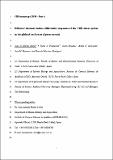Por favor, use este identificador para citar o enlazar a este item:
http://hdl.handle.net/10261/102218COMPARTIR / EXPORTAR:
 SHARE SHARE
 CORE
BASE CORE
BASE
|
|
| Visualizar otros formatos: MARC | Dublin Core | RDF | ORE | MODS | METS | DIDL | DATACITE | |

| Título: | Different stressors induce differential responses of the CRH-stress system in the gilthead sea bream (Sparus aurata) |
Autor: | Martos-Sitcha, Juan Antonio CSIC ORCID; Wunderink, Yvette S.; Straatjes, Justin; Skrzynska, Arleta K.; Mancera, Juan Miguel; Martínez-Rodríguez, Gonzalo CSIC ORCID | Palabras clave: | Cortisol Sparus aurata Food deprivation CRH CRH-binding protein Environmental salinity |
Fecha de publicación: | nov-2014 | Editor: | Elsevier | Citación: | Comparative Biochemistry and Physiology - A - Molecular and Integrative Physiology 177: 49-61 (2014) | Resumen: | The hypothalamus-pituitary-interrenal (HPI) axis, involved in the regulation of the neuroendocrine stress responses, presents important players such as corticotropin-releasing hormone (CRH, generally considered as the initiator of this pathway) and CRH-binding protein (CRH-BP, considered as an antagonist of CRH function). CRH and CRH-BP full-length cDNA sequences were obtained from Sparus aurata by screening a brain cDNA library, and their phylogenetic analysis as well as their roles during acute and chronic stress responses were assessed. mRNA expression levels and plasma cortisol concentrations were measured by RT qPCR and ELISA, respectively, in S. aurata juveniles submitted to: i) different environmental salinities in a short-time course response; and ii) food deprivation during 21. days. In addition, osmoregulatory and metabolic parameters in plasma corroborated a clear reorganization depending on the stress source/period. Salinity transfer induced stress as indicated by enhanced plasma cortisol levels, as well as by up-regulated CRH and down-regulated CRH-BP expression values. On the other hand, food deprivation did not affect both expression levels, although plasma cortisol concentrations were enhanced. These results suggest that different stressors are handled through different stress pathways in S. aurata. © 2014 Elsevier Inc. | Versión del editor: | http://dx.doi.org/10.1016/j.cbpa.2014.07.021 | URI: | http://hdl.handle.net/10261/102218 | DOI: | 10.1016/j.cbpa.2014.07.021 | Identificadores: | doi: 10.1016/j.cbpa.2014.07.021 issn: 1531-4332 |
| Aparece en las colecciones: | (ICMAN) Artículos |
Ficheros en este ítem:
| Fichero | Descripción | Tamaño | Formato | |
|---|---|---|---|---|
| crh_stress_system_Martos.pdf | 1,16 MB | Adobe PDF |  Visualizar/Abrir |
CORE Recommender
SCOPUSTM
Citations
49
checked on 16-abr-2024
WEB OF SCIENCETM
Citations
48
checked on 25-feb-2024
Page view(s)
316
checked on 23-abr-2024
Download(s)
360
checked on 23-abr-2024
Google ScholarTM
Check
Altmetric
Altmetric
NOTA: Los ítems de Digital.CSIC están protegidos por copyright, con todos los derechos reservados, a menos que se indique lo contrario.
